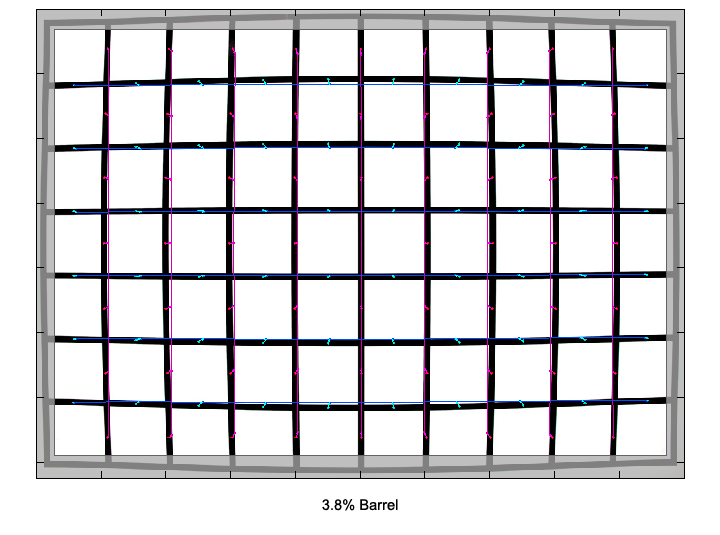|
Page 2 of 3

Distortion
At 24 mm the lens shows a heavy amount of barrel distortion (~3.8%), which flips over to a slight pincushion type (~0.9%) at 70mm. In the middle range the distortion is marginal.
|
Move the mouse cursor over the focal length text marks below to observe the respective distortion
|
| 24mm |
40mm |
70mm |
|

|
The chart above has a real-world size of about 120x80cm.
Vignetting
At 24mm f/2.8 the amount of vignetting is very pronounced at just above 1.7EV (f-stops), but can be decreased by stopping down. However, even stopped down to f/8 light falloff remains a bit on the high side and can still be seen in critical scenes.
Things look similar albeit slight better at other focal lengths - very visible vignetting wide open but stopping down helps to decrease the amount considerably. Regarding its ultra-large front element we hoped that the lens performed a little better here.
We're performing our vignetting analysis based on
(uncorrected) JPEGs straight from the camera. The JPG engine of the Nikon D3x features a rather flat
gradation curve, thus has a moderate contrast characteristic, resulting in comparatively low vignetting figures - the
corresponding Canon figures are roughly 40% higher due to the more
aggressive default contrast setting.

MTF (resolution)
The lens delivered very solid resolution figures in the MTF lab. At 24mm the center resolution is already superb at f/2.8. The border quality is on a good level at large apertures and improves to very good border results from f/4 onward. The corners require f/8 to jump across this rating barrier.
At the 40mm setting, the image center remains on a very high level. The borders and corners however start out lower at f/2.8, but stopped down to f/5.6 both reach very good resolution again.
At 70mm we are seeing a slight decrease in center performance at f/2.8. The contrast level is also slightly reduced here. However, the center is excellent from f/4 onward and the lens delivers very high quality results across the frame from f/5.6 to f/11. At f/11 there's a slight hint of diffraction (reduces the image quality) so you should avoid to choose an aperture beyond this setting if possible.
The Tamron lens has only a slight amount of field curvature throughout the zoom range. This is certainly an advantage compared to the Nikon AF-S 24-70/2.8, which has a somewhat "wavy" image field. On the other hand, the Tamron showed some focus shift when stopping down (residual spherical aberration).
Please note that the MTF results are not directly comparable across the different systems!
Below is a simplified summary of the formal findings. The chart shows line widths
per picture height (LW/PH) which can be taken as a measure for sharpness.
If you want to know more about the MTF50 figures you may check out the corresponding
Imatest Explanations

Chromatic Aberrations (CAs)
Chromatic aberrations (color shadows at harsh contrast transitions) are very well controlled and hardly relevant for most subjects at all tested aperture settings and focal lengths. This is quite impressive.
Please note that lateral CAs can easily be corrected in software or by the camera itself (most modern Nikon DSLRs remove CAs on-the-fly if you shoot JPGs).

Bokeh
Being a fast lens, it allows for good subject separation and thus the quality of out-of-focus blur is certainly of interest. We looked at bokeh with our standard test scene at 70mm focal length, which is closest to classic head to shoulder portrait lenses (~85mm).
The general quality of the background blur is quite smooth. However, the foreground blur is more busy.
Thanks to 9 rounded aperture blades, background highlights retain their circular shape throughout the whole aperture range. However, the inner area of the highlight disc is rather nervous - possibly a side effect of the aspherical elements. The highlight discs deteriorate a bit towards the usual "cat's eye" towards the borders. This effect can be reduced by stopping down. The highlight discs (in the center) remain circular even at f/5.6 so the design of the rounded aperture blades is obvious here.

Bokeh Fringing
Bokeh fringing (non-coinciding focal planes of the various colors) is an issue often found on fast lenses. It's visible as halos of different colors in out-of-focus areas - usually magenta (red + blue) in front the focus point and green beyond. Surprisingly the Tamron is only marginally affected.
If you scroll through the images below you may notice a slight shift in focus when stopping down. This is a so-called "residual spherical aberration".
Flare/Glare
The Tamron handles backlight quite well, but as almost any lens it can be forced to show flares nonetheless. When this happens, flare spots distribute across the frame at different positions (depending on the aperture chosen). In addition, there is some rainbow-like flare at the image border opposite to the light source.

|